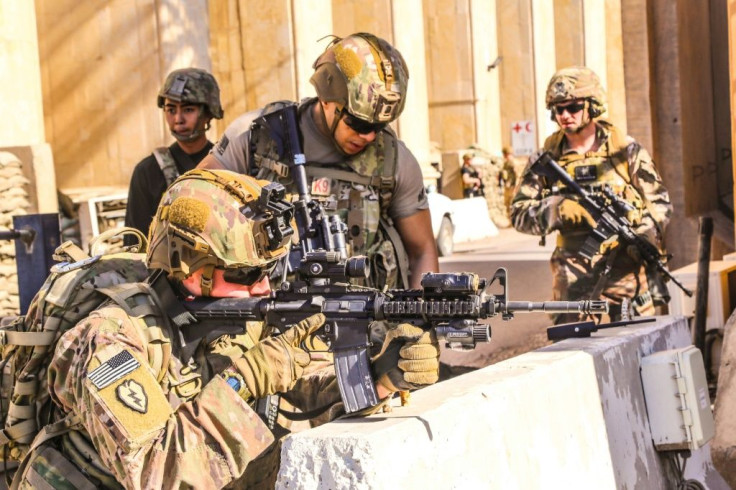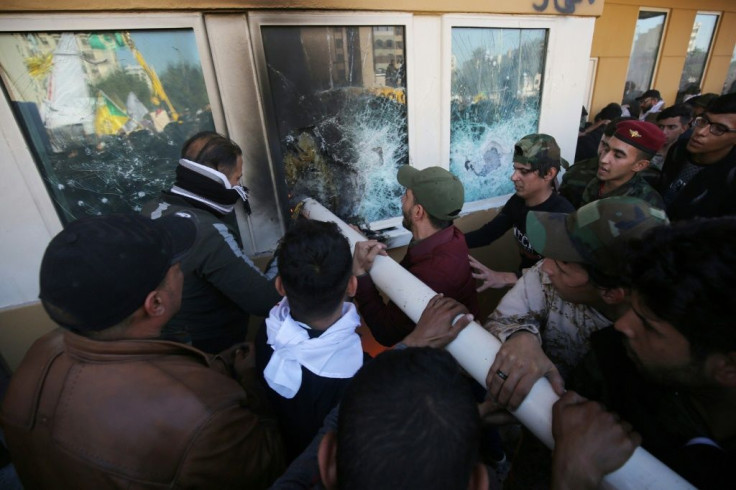Baghdad Embassy Siege: Marines Fire Tear Gas; US Troops Rushed To Middle East
More people Wednesday joined the siege of the U.S. embassy in Baghgad, now in its second day, by Iranian-backed protesters who had attempted to break into the compound the day before. U.S. Marines fired tear gas and rubber bullets at the protesters when they turned violent and tried to scale the embassy walls, injuring about 20 people.
The protesters have started withdrawing, reports said.
The siege has evoked memories of the Iran hostage crisis of 1979, when a group of U.S. diplomats and citizens was held hostage inside the Tehran embassy compound by college students supporting the Iranian Revolution. Iran seems to be following that playbook using its proxies in Iraq with the current siege in Baghdad.
Here is what you need to know on the embassy siege.
● U.S. Marines stationed in the compound fired tear gas and rubber bullets to push back protesters who lit a fire on the roof of the reception area. About 20 protesters were injured. The crowds had set US flags on fire and hurled rocks toward the embassy compound.
The reception area was damaged and windows smashed during Tuesday's violence; the walls of the embassy building were defaced with graffiti. The protesters had pitched tents near the embassy overnight.
● Iraq's INA state news said protesters have started withdrawing following a call by the the paramilitary militia that had called for the protests. But hardliners among the crowd continue to stay put.
● Iraq's U.S. trained counterterrorism forces are stationed around the perimeter of the embassy, but so far the government in Baghdad has shown little appetite to disperse the protesters using force.
● The protesters have threatened to stay until all U.S. diplomats and troops are pulled out of Iraq.
● The protesters also firebombed a second gate of the embassy, starting another fire, reports said. They had on Tuesday flung Molotov cocktails into the embassy compound and chanted "Death To America."
● Marines from a special purpose task force were dropped off by MV-22 Ospreys at the embassy compound Tuesday to bolster security for the compound.
December 31, 2019–
— Dan Scavino Jr. Archived (@Scavino45) January 1, 2020
U.S. Marine Corps MV-22 Ospreys drop off Special Purpose Marine Air-Ground Task Force-Crisis Response-Central Command Marines at the U.S. Embassy in Baghdad, Iraq.🇺🇸🇺🇸 pic.twitter.com/RgBTMVAKCg
Send the Marines@SPMAGTF_CR_CC deploys from Kuwait to Iraq to bolster security at the US Embassy and ensure the safety of American citizens there, Dec. 31. @StateDept pic.twitter.com/NQg4ZAYiGi
— U.S. Marines (@USMC) December 31, 2019
● About 750 paratroopers from the 82nd Airborne Division based in Fort Bragg, North Carolina, are heading toward Kuwait.
● Two Apache helicopters flew over the embassy Tuesday and dropped flares, seen as a signal from the U.S. government to the protesters that it will take decisive action if the lives of those inside the embassy compound is threatened.
VIDEO: AH-64 Apaches protect @USEmbBaghdad. 🚁“We have taken appropriate force protection actions to ensure the safety of American citizens...and to ensure our right of self-defense. We are sending additional forces to support our personnel at the Embassy.”~@EsperDoD 🇺🇸🇮🇶 pic.twitter.com/amABHBAOcL
— OIR Spokesperson (@OIRSpox) December 31, 2019

● The embassy advised U.S. citizens not to approach the building.
See posts, photos and more on Facebook.
● President Donald Trump warned Iran that it "will be held fully responsible for lives lost, or damage incurred, at any of our facilities" adding "This is not a Warning, it is a Threat. "
● Iran denied it was behind the protests at the embassy and warned against any retaliation.
"American officials have the astounding audacity of attributing to Iran the protests of the Iraqi people against (Washington's) savage killing of at least 25 Iraqis," Iranian Foreign Ministry spokesman Abbas Mousavi said in a statement carried on the ministry website.
● The attack on the embassy followed U.S. airstrikes Sunday on five locations in Iraq and Syria used by the Iranian-backed Kataeb Hezbollah to stockpile weapons. The strikes killed at least 25 militia members.
● The militia had Friday (Dec. 27), attacked a U.S. army base near Kirkuk, killing an American contractor and wounding several U.S. soldiers, prompting the U.S. response. The Kataeb Hezbollah are part of the umbrella Iran-backed Popular Mobilizaiton Forces that have fought with the Iraqi and U.S. troops to take back territory from the Islamic State.
● The Secretary-General of the Iraqi Kataib Sayyid al-Shuhada (KSS), a branch of the Popular Mobilization Forces, threatened to attack embassies of Saudi Arabia, the UAE, and Bahrain. The threat shows the attack on the U.S. embassy is more than a spontaneous eruption of popular anger but part of an Iranian plan to spread violence and fear in the region.
● President Trump, eager to avoid the confused approach of the Obama administration in 2012 when members of a militia stormed the U.S. diplomatic compound in Benghazi, Libya, has rushed additional troops into the embassy and to Kuwait.
● More than 5,000 U.S. troops are stationed in Iraq supporting local forces.
● An earlier plan to deploy up to 4,000 new troops to the Middle East is also being activated, and those troops could be on their way soon.

● The embassy compound, located in Baghdad's high security Green Zone, is in lockdown. U.S. Ambassador Matt Tueller was not at the embassy. The protesters had easily streamed through the many checkpoints on the way, with the Iraqi security forces not attempting to stop them.
● The State Department said it has no plans to evacuate the embassy immediately.
.@SecPompeo on @CBSNews: We never contemplated evacuating the facility today. But the American people should know that President @realDonaldTrump and our team are working diligently to make sure that we keep this facility secure. https://t.co/H7AUrHBdc1
— Department of State (@StateDept) January 1, 2020
© Copyright IBTimes 2025. All rights reserved.





















